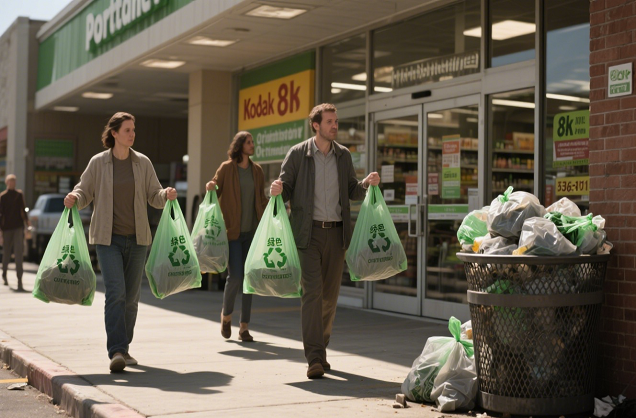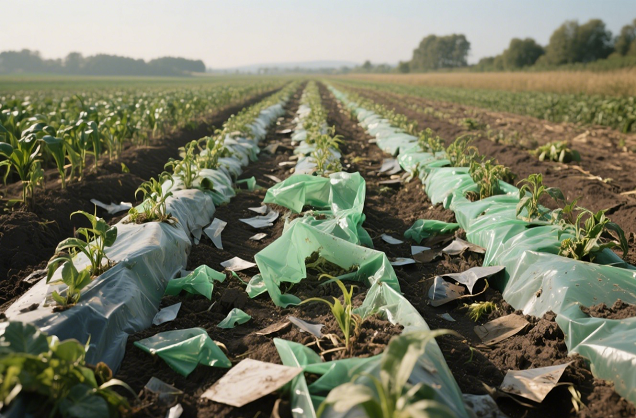Environmental shopping guide to avoid pit: these 4 types of “green” plastic do not buy
"Pseudo-environmental" plastics are deceiving consumers
In recent years, with the enhancement of environmental awareness, a large number of plastic products labeled as "biodegradable" and "environmentally friendly" have emerged on the market. However, the international environmental protection organization Break Free From Plastic 2024 report pointed out that: more than 60% of the "green" plastic can not be completely degraded, and some even more harmful than traditional plastic.

Category 1: Oxo-degradable plastics (Oxo-degradable)
How to identify?
? Package labeling:
"Oxo-degradable"
"12-24 months natural decomposition" (but no specific certification)
? Common products:
Supermarket shopping bags
Disposable cutlery
Courier packaging film
Why is it not environmentally friendly?
❌ Only breaks up into microplastics and cannot be completely broken down by microorganisms
❌ Banned in over 40 countries including the EU and Canada
❌ Adsorption of toxins is 3 times greater than ordinary plastics
? Experimental data (seawater immersion for 12 months):
Time Change in condition Microplastic release
0 months Intact 0 mg
6 months Cracking of the surface 150 mg/m²
12 months Breaks up into <1mm pieces 620 620 mg/m²

Category 2: Low-content starch blend plastics
How to recognize?
? Package labeling:
"30% plant-based"
"Partially biodegradable"
? Common products:
"Eco-friendly" cutlery sets
disposable lunch boxes
so-called "biodegradable" mulch
Why is it not environmentally friendly?
❌ Plastic skeleton remains after starch breaks down
❌ Contaminates composting system, requires additional sorting (cost +$120/ton)
❌ Cannot be recycled, ends up in incineration or landfill
? Microscopic observation:
Starch degrades to form a porous plastic structure
Adsorbs pesticides and heavy metals more than ordinary plastics

Category 3: Non-Standard Industrial PLA (not certified)
How do I recognize it?
? Packaging issues:
Labeled only "PLA" but no OK Compost/ASTM D6400 certification
Unusually low price (<$2.50/kg)
? Common products:
Cheap "biodegradable" straws
Some take-out containers
3D printing consumables
Why is it not environmentally friendly?
❌ Requires industrial composting facilities (58-60°C), little decomposition in home composting
❌ May release methane (CH₄) if landfilled
❌ Mixing into traditional plastics recycling streams reduces the quality of recyclate
?️ Temperature experiments:
Home composting (25-30°C): 15% decomposition in 12 months
Industrial composting (60°C): 90% decomposition in 6 months 90% decomposition

Category 4: Fake "ocean degradable" plastics
How to recognize them?
? Package labeling:
"Marine Friendly" but no TÜV Marine Degradable certification
Ingredients contain traditional plastics such as PE/PP
? Common products:
"Eco-friendly" fishing nets
Beachwear packaging
Watersports equipment
Why isn't it environmentally friendly?
❌ Only PHA is truly marine degradable
❌ Hardly decomposes in salt water, harming marine life
❌ Easily ingested, leading to animal deaths
? Real life examples:
Mediterranean Sea Turtle Rescue Center Report 2023:
Pseudo-degradable plastic fragments were found in the stomachs of 67% of the rescued turtles
42% of which were labeled "eco-friendly"
Truly Eco-Friendly Alternatives for 2024
1. Home Composting Grade Materials
✅ Certification Mark: OK Compost HOME
✅ Featured Products:
BioBag Food Waste Bags (PLA+PBAT)
TIPA Flexible Packaging Films
2. Marine Biodegradable Materials
✅ The Only Choice: PHA (Polyhydroxy Fatty Acid Esters)
✅ Representative Brands:
Danimer Scientific ( PHA Straws)
RWDC Industries (PHA Food Containers)
3. Everyday Alternatives
Uses Best Alternative Suboptimal Alternative
Shopping Bags Cotton Bags (Used 50+ Times) Certified PBAT Bags
Takeaway Packaging Bagasse Lunch Boxes Pure PLA Lunch Boxes
Beverage Straws Stainless Steel Straws PHA Straws
 Significant progress in PBAT/s
Significant progress in PBAT/s
 PLA/PBAT composite film degrad
PLA/PBAT composite film degrad
 A New Choice for Takeaway Pack
A New Choice for Takeaway Pack
 Significant progress in PBAT+s
Significant progress in PBAT+s
CONTACT
Add: Room 4006, No.1 Helong Yiheng Road, Baiyun District, Guangzhou City
Tel: +8613450255948
Wechat : +86-13450255948
Fax: +86-13450255948
E-mail: 13450255948@163.com








